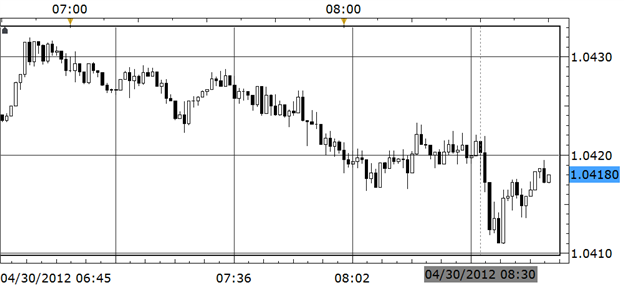The Dow Jones FXCM Dollar Index (Ticker: USDOLLAR) moved to retake some of its losses from Friday after personal income and spending data showed a strengthening American consumer, at least on the savings end. Despite the uptick in data, the Japanese Yen remained the top performer on Monday.
The US Dollar has been the ugly duckling of the FX market the past few days, especially in light of Friday’s disappointing first quarter growth reading. Reprieve arrived today as the world’s reserve currency found support not only on the safety/risk-aversion move, rooted in the weak Spanish growth data, but from stronger than expected US data as well. The US Dollar’s strength was bolstered ahead of the US cash equity open as personal income and spending data from March arrived.
The American consumption binge that took place the past few months appears to be over. Personal spending dropped to a rate of 0.3 percent month-over-month in March, below the 0.4 percent forecast provided by Bloomberg News and significantly worse than the revised 0.9 percent growth figure from February. On a more encouraging note, personal income grew by 0.4 percent from 0.3 percent in February, against an expected print of 0.3 percent.
While rising income and falling spending are the signs of a fiscally leaner American consumer, by no means does today’s print offset the negative outlook surrounding the US Dollar following Friday’s significant GDP print miss. In fact, today’s personal spending figure may stoke some worries – after all, consumption accounts for approximately 70 percent of the headline GDP figure for the United States.
AUDUSD 1-minute Chart: April 30, 2012

On the back of the news, the US Dollar rallied briefly, with the Dow Jones FXCM Dollar Index (Ticker: USDOLLAR) climbing to a fresh daily high of 9843 before pulling back to 9837. The EURUSD was stronger immediately after the print while both the AUDUSD and USDJPY fell. The USDJPY’s move is of greater interest, as the tug-and-pull between the US Dollar and the Japanese Yen is a strong indicator of whether or not market participants are expecting more quantitative easing by the Federal Reserve.
Also released today were the personal price consumption expenditure figures for March, which are the Fed’s newest ‘official’ gauge of inflation. Core PCE was stable in line with expectations in March on both the month-over-month and year-over-year readings at 0.2 percent and 2.0 percent, respectively. While price pressures remain within the Fed’s medium-term target of 2 percent, it is worth noting that the core PCE y/y figure closed at its highest such reading since November 2008.
0 comments:
Post a Comment